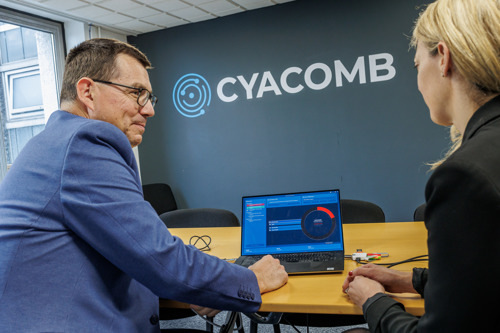
Imagine the frustration of police and counter-terrorism officers when they find the laptops of potential child abusers or terrorists and have to wait a year for their technical laboratories to see if there is actionable evidence on those devices.
This was the scenario until lan Stevenson and the spinout team from Napier University that he leads, found a world-beating solution to this problem.
"We produce what can be thought of as a digital 'breathalyser'. It is a combination of software and a USB stick," Stevenson explains. When a policeman or an anti-terrorist officer inserts the USB into a live suspect device, the hard drives are scanned in seconds. The device produces a "traffic light' dashboard.
A red light means either child sexual abuse material or terrorist material has been discovered. Green means the device is clear, while amber indicates the presence of a suspiciously large amount of encrypted data. Arrests can then be made immediately, with a high degree of confidence that appropriate evidence has been found or can be decrypted.
Not surprisingly, a large number of police forces and intelligence agencies around the world have become customers of Cyacomb, the company that Stevenson leads. It is yet another amazing 'first' out of Scotland, proving yet again how far above its weight Scotland can punch when the country puts its best foot forward.
Stevenson's journey to becoming a serial entrepreneur with successes of this magnitude under his belt began with a degree in computer science and electronic engineering at Edinburgh University.
"I was always interested in the intersection between hardware and software. In fact, my first job was in a spin-out company from Edinburgh University, called VSLI Vision. They did microchips for some of the first cameras in mobile phones and computers," he recalls. This was back to the late 1990s.
Stevenson soon found that the business of making technology a success in the marketplace intrigued him as much as the actual tech itself. As a consequence, he moved to a Cambridge consulting firm where the common theme was helping companies put new technologies to work in the real world.
"One of the biggest places where the wheels come off for new tech companies is the gap between the technology and the product. The product is so much more than the technology," he notes.
He points out that so much of the new tech that excites people in universities and R&D departments fails to get any traction with real-world problems.
Another problem is that even when a piece of technology really does have a real-world application, turning that technology into a product that will sell in the marketplace involves wrapping so much more around it, including software and user interfaces, plus a coherent business case. One of the paradoxes of our industry is that the more sophisticated the technology is, the less the market has the natural capacity to understand it," he notes.
In his time with the consultancy. Scientific Generics, which later became Sagentia, Stevenson's activities spanned everything from analysing technology and business cases to helping companies prototype their products.
“The more sophisticated the tech is, the less the market has the natural capacity to understand it.”
"I was there for four years. Then I moved back to Edinburgh and worked for CHIL as Chief Technology Officer (CTO) from 2004 to 2008. I already knew how to think about problems in engineering and science. I had lots of mental models to help me here, but the job of a CTO has a far stronger business component to it, and I had far fewer tools for that," he remembers. Realising that he needed to sharpen up his business management skills, he took a year out in 2009 to sign up for the Saltire Foundation (Entrepreneurial Scotland) Fellowship.
"They sent us to one of the top business schools in the US, Babson College for four months. Then I went to Paolo Alto on a placement with Sun Microsystems, which gave me a completely different view of business and technology."
He returned to Scotland to a second company placement, then spent four years. helping start-up Scottish businesses put together their business plans, and find funding.
"I had my own consultancy business doing this. It was hugely enjoyable, but I was always on the lookout for a technology opportunity that I could become part of, and that had the potential to be globally scalable," he comments.
In 2015, Stevenson found that opportunity, working with the research group at Napier University. Cyacomb is the result. It was spun out with the co-founder of the technology that underlies the company's success.
"What we realised was that digital forensics all around the world is done back in the laboratory. Labs get totally backed up with traditional ways of hacking into and analysing laptops. That produces a huge delay between the front-end services, which apprehend the suspect and find the equipment, and the final analysis from the lab. This was a perfect real-world need that we focused on solving." he notes.
The company spun out in 2016 with a very modest investment. "Initially, it was just me and my co-founder, along with two engineers, focused on building a product out of the research. In 2018 we won our first significant contract and by 2019 we had the UK Home Office deploying our products nationally for policing across the UK. Then the world markets opened up. The journey still has a long way to run," he concludes.